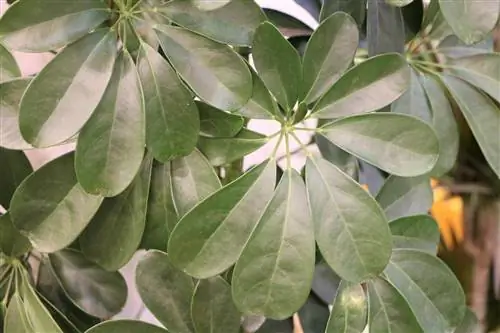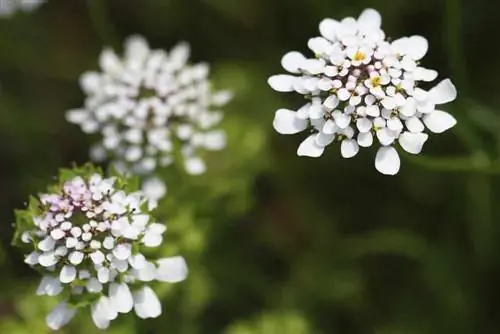- Author admin [email protected].
- Public 2023-12-17 03:39.
- Last modified 2025-01-24 12:45.
On the radiant aralia, only the upper shoots are cut in early spring. However, if the plant has grown significantly in height, the radiant aralia can also be cut more radically and thinned out a little. To do this, you cut directly above an eye or a leaf. When using sharp and clean cutting tools and following the correct procedure, the lacquer leaf recovers quickly from the procedure and often shows denser growth. The shoot pieces resulting from cutting can be used directly for propagation.
Propagate
The propagation of the radiant aralia is very easy and can be done directly by rooting a shoot. To do this, a 15 cm long shoot is cut off in early spring, around March. The cutting surface is beveled to increase its surface area. The shoot can then be placed in a dark vase filled with soft water. The leaves must not come into contact with water. If the first fine roots appear after four weeks at the earliest, the shoot is placed in potting soil and cared for in the same way as the mother plant. Alternatively, the shoot can be placed in moist soil immediately after cutting and stabilized with a thin stick. However, the substrate must always be kept slightly moist without being soaked. This greater effort must be carried out until the first new leaves appear. Watering can then be slowly reduced, allowing the soil surface to dry before the next watering.
Repotting
Repotting can also take place at the same time as propagation, which is carried out at least every two years or when the roots grow out of the pot. In any case, a pot that is just one size larger is chosen. To do this, proceed as follows:
- The old substrate is removed as completely as possible but of course carefully. Anything that cannot be removed when dry is rinsed off with water.
- If necessary, a drainage layer is first added to the pot, followed by a small amount of soil.
- The root ball is inserted and the pot is filled with soil. To avoid later sagging, the substrate should be completely moistened and, if necessary, refilled.
Wintering
There are two options available for overwintering the radiant aralia. On the one hand, the plant can simply remain in its usual location. Here it continues to be watered, but the amount of water should be adjusted. In heavily heated rooms with dry air, you can usually water as usual. If it is a little cooler, watering is reduced. The situation is similar with fertilization. When the winter is warm and bright, this only happens once a month and the dosage can also be reduced. The radiant aralia can also be overwintered in a cool place, but it should not be completely dark. Temperatures of around 15 °C to 18 °C are tolerated. A room that is heated less often or more easily, such as the bedroom, is therefore suitable. With this variant, fertilization can be stopped completely, but the soil must not dry out. Watering is therefore also carried out during the cooler winter months, but only in small quantities.
Possible care errors
The radiant aralia is not susceptible to diseases or pests, but if some care mistakes are made, it will quickly drop a lot of leaves. The most common reason for gradual baldness is a lack of water or the opposite, i.e. soil that is too moist. The cause can also be drafts or temperatures that are too low. Yellowish discoloration due to over-fertilization does not occur very often. The additional nutrient supply must then be stopped immediately; it is also recommended to change the substrate completely.
Conclusion of the editors
With the right knowledge, little can go wrong when caring for radiant aralia. If it is cultivated correctly, it can not only improve the air, but also rewards the effort with decorative flowers.
What you should know about radiant aralia in brief
- The radiant aralia grows into a real tree in the wild, but the smaller varieties are also used as houseplants.
- This is a robust and easy-care green plant whose individual leaves are arranged in a radial pattern.
- On young plants, only a few leaves usually form a ray shape, but over time there are more and more.
- There are varieties of the radiant aralia with dark green leaves, but varieties with variegated leaves are increasingly being offered.
Care
- The radiant aralia needs a bright place by the window, but should not be exposed to the midday sun.
- A window facing east or west is best suited for this plant, where it gets sufficient sunlight in the morning or evening.
- It should be watered moderately and grows fastest if it is only watered again when the top layer of the substrate has dried. However, the root ball should not dry out completely, otherwise the plant will quickly shed its leaves.
- The radiant aralia does not tolerate drafts and cold temperatures well, but likes high humidity.
- Especially with the dark green variety, the leaves should be cleaned from dirt and dust every now and then with a damp cloth so that they shine beautifully again and the plant can breathe easily.
- During the summer, the radiant aralia can be fertilized with a conventional fertilizer for green plants.
- With good care, a radiant aralia can grow very quickly and may then need support. It becomes a little bushier and then also without support if new shoots are cut off at the top.
- A plant that has grown too large can also be cut back in spring.
- In summer, the plant can be placed on the terrace, but it is important to remember that the radiant aralia cannot tolerate temperatures below 10 °C.
He alth benefits and harms
Like other green plants, the radiant aralia ensures good air in the living space and is therefore particularly interesting for households where people smoke. The more leaves it has, the more it acts like a room air filter and even breaks down formaldehyde. However, a radiant aralia is only partially suitable for households with children and pets because it is poisonous. Its leaves contain oxalate crystals, which can cause vomiting diarrhea, loss of appetite and irritation of the mucous membrane after consumption.






